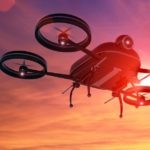Europe sets its sights on civil drones
The European Union is keen to take the lead in a sector that has the potential to move up to 15 billion euros a year… provided that precise regulation is put in place.

Europe has the highest number of civil drone operators –2,500 compared to 2,342 in the rest of the world– according to a recent European Union assessment report on drones. The European body is keen to regulate a market that has seen a boom in recent years. The EU aspires to lead the remotely piloted aircraft sector, and is urgently demanding the creation of a worldwide regulation that would stimulate the market.
To achieve this it believes it is essential to have a common law in order to attract investors. This legal limbo or improvised legislation –work is currently underway on a definitive law in several countries including Spain– is holding back the civil drone industry. These new regulations must be based on the principles of the Riga declaration of last March:
1. Drones should be regarded as a new type of aircraft (and must be governed by rules that correspond to the risks inherent in each operation).
2. It is imperative to draft European rules for operating drones as soon as possible and establish precisely the security regulations so as to encourage investment in the sector.
3. Technologies and standards must be designed to enable the integration of drones into European airspace.
4. Public acceptance of drones is essential for the growth of the services associated to these devices.
5. The drone operator is responsible for its use.
The EU's draft report, which is due to be debated in September 2015, notes that remotely piloted aircraft must coexist with planes even in the same airspace. It therefore specifies: “It is advisable to draw up a series of clear, global and harmonized regulations –based on an assessment of the risks– which do not impose excessively strict regulations on companies which could hinder the investment and the creation of employment” in the drone universe.
The report repeatedly underlines the potential economic importance of the large-scale use of drones. “The sector and the regulatory bodies must reach an agreement and work together to ensure that companies are not reluctant to invest in the development of the necessary technologies because of the perceived uncertainty in the legislation”.
The risks of using drones without regulation
The Article 29 Working Party (Art. 29 WP) –formed by all the European data protection agencies– is another group that has requested harmonization in all European countries. In its first ruling it highlights the risk the use of drones equipped with sensors represents for personal data, either by capturing images, sound or geolocation data.
It also considers that it is of “paramount importance” that the person responsible for processing the data and his or her supervisor should be clearly identified for each type of operation.
It stresses the need for manufacturers to adopt privacy measures starting at the design stage and by default, and suggests conducting impact assessments on data protection as a means of determining the impact of drones on this fundamental right.
To increase awareness among users it also recommends that sufficient information should be included in devices with smaller dimensions with regard to the intrusive potential of these technologies, and wherever possible, that there should be a clear indication of where their use is permitted. The operators of these devices should as far as possible avoid flying over private areas and buildings, even when this is allowed.
The EU is not the only organization set on regulating this sector to allow it to flourish. The Economist points out that the sector's potential will depend on its regulation. According to the Commission, remotely piloted aircraft are expected to generate 150,000 jobs and profits of around €15 million a year in Europe in 2050. These estimates will only become a reality if they are accompanied by precise regulations that do not scare away investors and technology companies, or the public itself.
United Kingdom Drone Code
Like the rest of Europe, the United Kingdom is waiting for EU legislation to be introduced on drones, but the country also has its own regulations in place. Such aircraft have proliferated over recent years, leading the Civil Aviation Authority (CAA) to launch a “drone code” in late July to raise awareness of the latest legal requirements and best practices when using drones.
“We launched the code on the 22nd and it received extensive coverage in the media and on Twitter. We provide guidelines on how to fly drones safely and legally," says Nathan Lovett, member of the CAA.
Lovett does not anticipate major problems despite the rising number of drones. "We think drone regulations are reasonable and proportionate. They do the job of protecting the public without being too restrictive, and they don't affect the pleasure of recreational use. We are aware that all new technologies may be used with criminal intent, and drones are no exception. Police services take such risks very seriously. In extreme cases people may be prosecuted."
With regard to potential problems (the most recent example came when an Airbus A320 nearly collided with a drone at Heathrow Airport), he called for responsible conduct from all parties. “At the end of the day, it's down to each individual to behave properly and abide by the law”, he concluded.